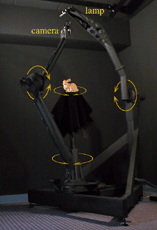Web page and text by Marc Levoy
February 12, 2002
Overview
The Stanford Spherical Gantry is a room-sized goniometer, consisting of two
computer-controlled arms that describe concentric shells around an object
platform. A variety of illumination and sensing devices can be mounted on the
arms. The clear working volume above the object platform is 40 cm in diameter.
Originally conceived as a device for acquiring full-surround light fields of
small objects, the Stanford Spherical Gantry has proven useful for a variety of
measurement projects in our laboratory, ranging from capturing the reflected
light field of a painted statuette to characterizing scattering from a single
human hair fiber.
Geometric design
The object platform, on which the Stanford bunny has been placed in the image
at right above, has one degree of rotational freedom, denoted by the orange
arrow in the image. The inner arm, labeled "camera" in the image above, has
two degrees of rotational freedom, permitting it to traverse any point on the
surface of a sphere centered on the object platform (except for a 10-degree
stayout at the bottom). The outer arm, labeled "light" in the image, has only
one degree of rotational freedom. However, this last axis, combined with
rotation of the object platform, effectively permits the outer arm to also
traverse (almost) any point on the surface of a sphere relative to the object
on the platform.
Illuminators and sensors
The inner arm currently has a high-quality 3-CCD digital still/video camera
mounted on it. We designed this arm to also accommodate a triangulation range
scanner. The outer arm currently has a focusable broadband point light source
on it, conducted to the end of the arm using a fiber-optic cable. We designed
this arm to also accommodate a video projector. In this configuration, the
arms and platform provide 4 degrees of freedom (DOFs), the camera provides 2
DOFs (pixel u and v coordinates) and the projector provides another 2. This
provides the ability to generate any 4D incident light field, and for an object
placed on the platform measure the reflected 4D light field. The resulting
function is 8-D! Note that some points in this 8D space cannot be measured
using our gantry, in particular retroreflection, because the camera would block
the light source. Also, the camera and its arm will cast shadows on the object
under certain illumination conditions.
Accuracy
In addition to its flexibility, the gantry is stiff, and its motions are
accurate and repeatable. As an example, the end of the inner arm, which lies
about 1 meter from the center of the working volume, can be positioned to
within 0.2mm. If a camera is mounted on this arm, its angular deflection,
hence its aiming error, will be less than 0.02 degrees. This is sufficiently
accurate to capture a light field in which which rays that are supposed to
cross in a voxel measuring 0.4mm on a side (e.g. to implement Steve Seitz's
voxel coloring algorithm over the 40cm working volume, assuming a 1000 x 1000
pixel camera) can be trusted to cross there.
Credits
The gantry geometry was conceived by Marc Levoy and Brian Curless. Its
accuracy requirements were analyzed by Marc Levoy and Szymon Rusinkiewicz, with
input from Pat Hanrahan. The structure and mechanics were designed by Duane
Fulk of Cyberware Inc., who also oversaw fabrication and testing. Calibration
of the gantry was performed by Szymon Rusinkiewicz. Steve Marschner improved
the light source and performed further calibration. Our current gantry guru is
Mike Cammarano. The gantry cost $130,000 to design and build. Financial
support for building the gantry was provided by Interval Research.
Design alternatives
The problem of measuring the angular dependence of reflection and scattering is
well studied in the applied physics community, where the devices are generally
called scatterometers or gonioreflectometers. The working volume of our device
is larger than most of these, and we were unwilling to require that the object
be fixtured. This enables us to digitize casually placed collections of
objects, or nonrigid objects like cloth or liquids, which would change shape if
rotated. However, this requirement forced us to look at novel geometric
designs. Here are a few of the many designs we considered:
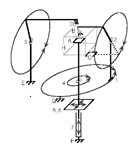
|
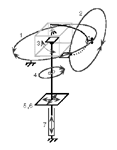
|
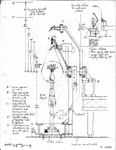
|
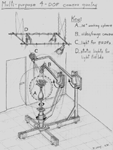
|
|
July 11, 1996
|
July 12, 1996
|
July 18, 1996
|
September 8, 1996
|
|
First practical design, with translating arms on tall posts
and a roller bearing
|
Alternative design with no posts,
but a large equitorial roller bearing
|
A simpler design, with rotating arms instead of translating arms
|
Essentially the same design, but with the collision eliminated
|
Click on a drawing to bring up larger version, some with explanatory notes.
Click here for an incomplete draft set of
specifications, including sizes and tolerances. These are not the
specifications for the final (as built) gantry. And here is an informal discussion of these specifications by Szymon
Rusinkiewicz
Published papers that used the gantry
We envisioned four uses for the gantry:
- Digitizing 4D full-surround light fields under arbitrary illumination
- Measuring 6D spatially varying BRDFs and BDTFs
of 2D samples and 3D objects
- Measuring 8D BSSRDFs, or equivalently, incident 4D light fields x
reflected/transmitted 4D light fields
- Range scanning of 3D objects with automated next best view
Not all of these uses have yet been realized. Here is a list of published
papers (current to 2004) whose data was acquired on the gantry. These are
listed in inverse chronological order.
- Light Scattering from Human Hair Fibers,
-
Marschner, S., Jensen, H.W., Cammarano, M., Worley, S., Hanrahan, P.,
-
Proc. SIGGRAPH 2003.
- Conveying Shape and Features with Image-Based Relighting,
-
Akers, D., Losasso, F., Klingner, J., Agrawala, M., Rick, J., Hanrahan, P.,
-
Proc. IEEE Visualization 2003.
-
Light Field Mapping: Efficient Representation and Hardware Rendering of
Surface Light Fields,
-
Bouguet, J.-Y., Grzeszczuk, R., Chu, M.,
-
Proc. SIGGRAPH 2002.
-
See also their
OpenLF project on Source Forge.
-
Image-Based Hair Capture by Inverse Lighting,
-
Grabli, S., Sillion, F., Marschner, S.R., Lengyel, J.E.,
-
Proc. Graphics Interface 2002.
-
A Practical Model for Subsurface Light Transport,
-
Jensen, H.W., Marschner, S., Levoy, M., Hanrahan, P.,
-
Proc. SIGGRAPH 2001.
-
Surface Light Fields for 3D Photography,
-
Wood, D.N., Azuma, D.I., Aldinger, K.,
Curless, B., Duchamp, T., Salesin, D.H., Stuetzle, W.,
-
Proc. SIGGRAPH 2000.
-
A New Change of Variables for Efficient BRDF Representation,
-
Rusinkiewicz, S.,
-
Proc. 1998 Eurographics Rendering Workshop.
Click here for our other papers on
light fields,
and here for our other major light field acquisition device, the
Stanford Multi-Camera Array.
Click here for a full list of our lab's
technical publications,
here for our other
research projects, or here to return to our home page.
Next-generation gantries
The design drawings for the Stanford Spherical Gantry are available (for free,
we think) from Cyberware, if anybody would like them. As of August 2005, we
know of two descendents of our gantry:
-
Steve Marschner, formerly a postdoc at Stanford, now at Cornell University, has
built a version that improves the mounting arrangement at the ends of the two
arms. This permits more flexibility in the illumination and imaging devices
that can be attached to these arms.
-
Henrik Wann Jensen, also formerly a postdoc at Stanford, now at UC San Diego,
is building a version in which the outer arm has the same degrees of rotational
freedom as the inner arm. This permits the object platform to be stationary,
which facilitates measuring delicate objects or objects illuminated by complex
lighting.
-
Jason Lawrence, a former student of Szymon Rusinkiewicz, has built a version
that is identical to Steve Marschner's, but with coaxial light/camera devices
designed and mounted to each of the arms. This setup has some nice properties
for jointly measuring an object's 3D geometry and surface reflectance, as
described in
this paper.
Copyright © 2004-2005 Marc Levoy
Last update:
August 13, 2010 01:45:55 PM

